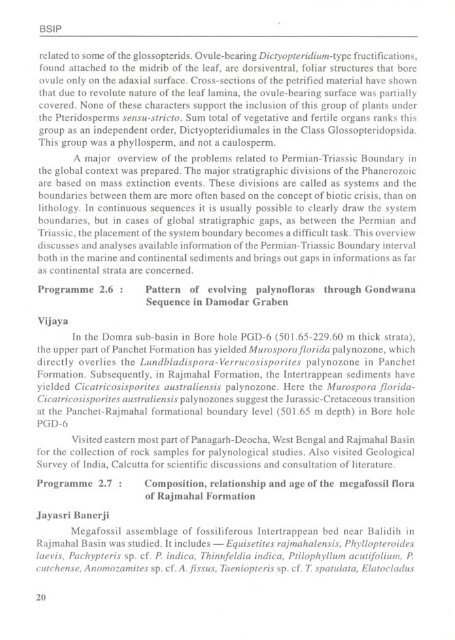1996-97 - Birbal Sahni Institute of Palaeobotany
1996-97 - Birbal Sahni Institute of Palaeobotany
1996-97 - Birbal Sahni Institute of Palaeobotany
You also want an ePaper? Increase the reach of your titles
YUMPU automatically turns print PDFs into web optimized ePapers that Google loves.
BSIP<br />
related to some <strong>of</strong> the glossopterids. Ovule-bearing Dictyopteridium-type fructifications,<br />
found attached to the midrib <strong>of</strong> the leaf, are dorsi ventral, foliar structures that bore<br />
ovule only on the adaxial surface. Cross-sections <strong>of</strong> the petrified material have shown<br />
that due to revolute nature <strong>of</strong> the leaf lamina, the ovule-bearing surface was partially<br />
covered. None <strong>of</strong> these characters support the inclusion <strong>of</strong> this group <strong>of</strong> plants under<br />
the Pteridosperms sensu-stricto. Sum total <strong>of</strong> vegetative and fertile organs ranks this<br />
group as an independent order, Dictyopteridiumales in the Class Glossopteridopsida.<br />
This group was a phyllosperm, and not a caulosperm.<br />
A major overview <strong>of</strong> the problems related to Permian-Triassic Boundary in<br />
the global context was prepared. The major stratigraphic divisions <strong>of</strong> the Phanerozoic<br />
are based on mass extinction events. These divisions are called as systems and the<br />
boundaries between them are more <strong>of</strong>ten based on the concept <strong>of</strong> biotic crisis, than on<br />
lithology. In continuous sequences it is usually possible to clearly draw the system<br />
boundaries, but in cases <strong>of</strong> global stratigraphic gaps, as between the Permian and<br />
Triassic, the placement <strong>of</strong> the system boundary becomes a difficult task. This overview<br />
discusses and analyses available information <strong>of</strong> the Permian-Triassic Boundary interval<br />
both in the marine and continental sediments and brings out gaps in informations as far<br />
as continental strata are concerned.<br />
Programme 2.6 : Pattern <strong>of</strong> evolving palyn<strong>of</strong>loras through Gondwana<br />
Sequence in Damodar Graben<br />
Vijaya<br />
In the Domra sub-basin in Bore hole PGD-6 (501.65-229.60 m thick strata),<br />
the upper part <strong>of</strong> Panchet Formation has yielded Murosporaflorida palynozone, which<br />
directly overlies the Lundbladispora- Verrucosisporites palynozone in Panchet<br />
Formation. Subsequently, in Rajmahal Formation, the Intertrappean sediments have<br />
yielded Cicatricosisporites australiensis palynozone. Here the Murospora florida<br />
Cicatricosisporites australiensis palynozones suggest the Jurassic-Cretaceous transition<br />
at the Panchet-Rajmahal formational boundary level (501.65 m depth) in Bore hole<br />
PGD-6<br />
Visited eastern most part <strong>of</strong>Panagarh-Deocha, West Bengal and Rajmahal Basin<br />
for the collection <strong>of</strong> rock samples for palynological studies. Also visited Geological<br />
Survey <strong>of</strong> India, Calcutta for scientific discussions and consultation <strong>of</strong> literature.<br />
Programme 2.7 : Composition, relationship and age <strong>of</strong> the megafossil flora<br />
<strong>of</strong> Rajmahal Formation<br />
Jayasri<br />
Banerji<br />
Megafossil assemblage <strong>of</strong> fossiliferous Intertrappean bed near Balidih in<br />
Rajmahal Basin was studied. It includes - Equisetites rajmahalensis, Phyllopteroides<br />
laevis, Pachypteris sp. cf. P. indica, Thinnfeldia indica, Ptilophyllum acutifolium, P<br />
cutchense, Anomozamites sp. cf. A.jissus, Taeniopteris sp. cf. T spatulata, Elatocludus<br />
20

















